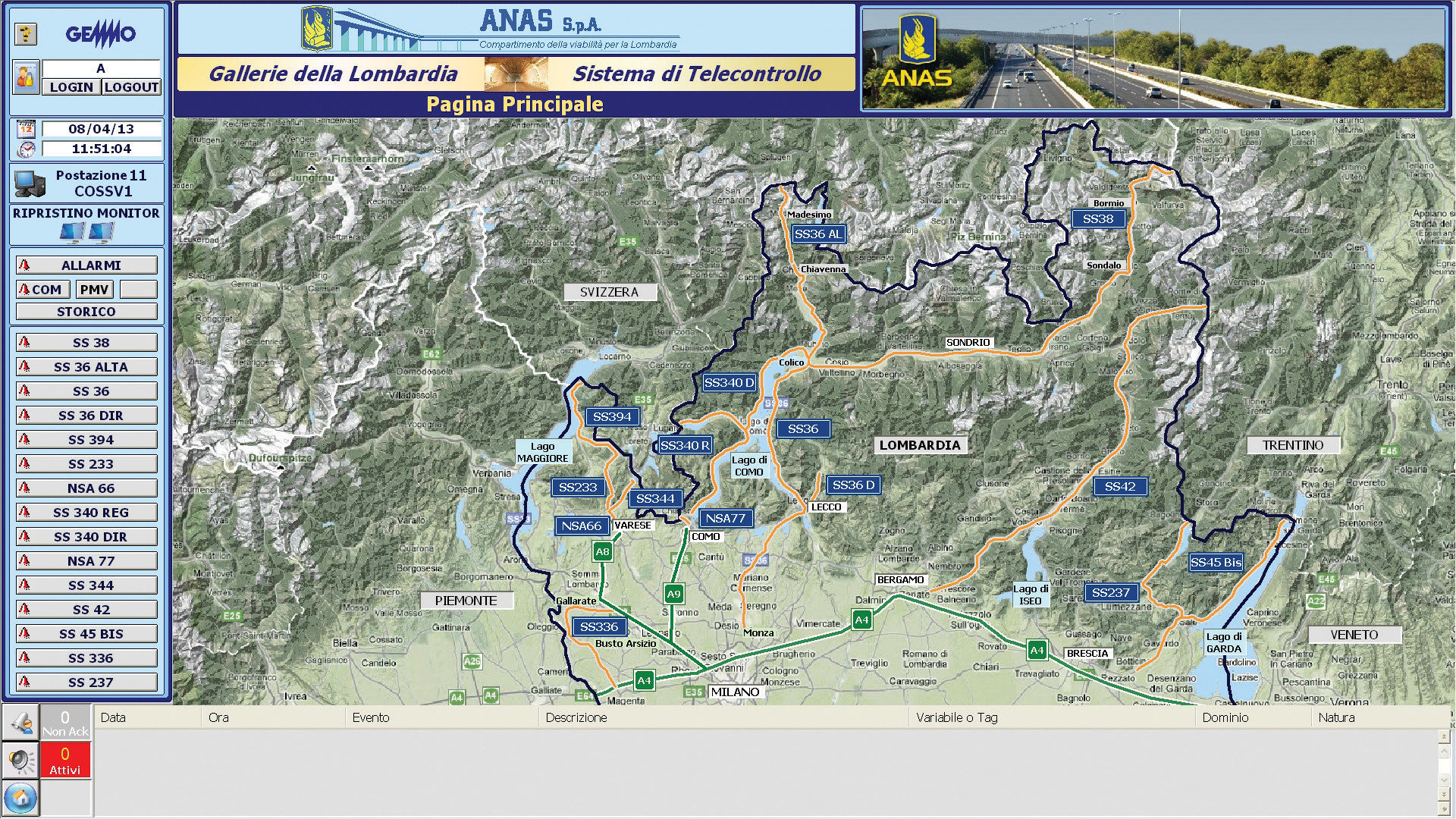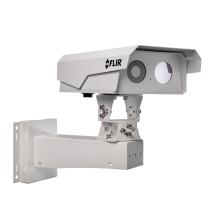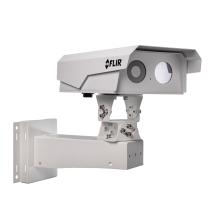Traffic control system manufacturers have recently supplied some of their cutting-edge technology to major projects in Europe. Meanwhile, in southern Asia, another leading firm in the sector is helping reduce chronic traffic congestion in Indonesia’s capital, Jakarta. Guy Woodford reports
Solutions supplied by Siemens Mobility & Logistics (M&L) are helping the Rijkswaterstaat improve traffic conditions at the Coentunnel in Amsterdam, one of the most heavily used traffic arteries in the Netherlands, used

The supervision and telecontrol system designed and implemented by Gemmo and based on PcVue from ARC Informatique
RSS2768 Siemens Mobility & Logistics (M&L) are helping the Rijkswaterstaat improve traffic conditions at the Coentunnel in Amsterdam, one of the most heavily used traffic arteries in the Netherlands, used by 100,000 vehicles every day. The tunnel, which links Amsterdam to the province of North Holland, has been a cause of traffic congestion and delays for many years. A much-needed second tunnel opened in spring 2013, together with a three kilometre-long elevated section of freeway connecting the tunnel with the southern part of the city to relieve the heavily-used A10 route.
At the heart of the solution is the tunnel control centre's Sitraffic ITCC, which monitors and manages all of the operating and traffic systems and all of the outdoor equipment. A closed-circuit television system (CCTV) provides traffic monitoring, while the integrated automatic incident detection (AID) system provides identification of smoke as well as congestion and accidents.
Siemens M&L also equipped the elevated section with state-of-the-art traffic technology including a traffic management system, monitoring technology and technical infrastructure components such as communication and camera technology.
To meet stringent safety requirements for the elevated section, Siemens M&L used safety technologies similar to those used in the tunnel: sensors along the elevated section measure traffic volume and flow and automatically notify the control centre in the event of stationary traffic, slow-moving vehicles and wrong-way travel.
In the UK, Siemens M&L was recently awarded a contract by Manchester City Council to supply unattended bus lane enforcement cameras to sites across the whole city. Working with Zenco Systems, a UK-based bus lane enforcement equipment supplier, the Siemens M&L-led enforcement solution will enable the Council to identify unauthorised vehicles using the lanes restricted for the unhindered flow of buses, capture them on camera and prepare an evidential record to support the issue of an enforcement notice. The cameras are redeployable and will be moved around a variety of locations to provide maximum coverage.
Included in the contract is the supply, installation and maintenance of 15 Lanewatch cameras, two review stations and instation software, all to be hosted in the cloud, together with the provision of three years’ maintenance and option for a further two-year extension.
In the Lombardy region of Italy, a new tunnel safety supervision and remote control system has been designed and implemented by Gemmo. Based on the PcVue SCADA system from7516 ARC Informatique, it is said to ensure the comfort and safety of vehicle users along over 140km of road tunnels.
The system is being applied to the technological requalification and safety management of approximately 100 tunnels on state roads managed by1184 ANAS in Lombardy. The wide scope includes the technological requalification of the tunnels and standardisation or renovation of power, lighting, ventilation, video-safety and data transmission plants. The single or dual ‘pipe’ tunnels have lengths ranging from 250m to 5km.
The estimated value of the work is approximately €140 million, financed equally by ANAS and the private sector. Tunnel Gest (a company whose majority shareholding is held by Gemmo) has a 17-year contract to manage what became a realised project in June 2013, at the end of the three-year construction and requalification period. This timeframe, which was defined in the financial plan at the start of the project, is said to allow the company to make a return through the provision of services such as plant maintenance. The road management will remain ANAS’s responsibility.
“The first stage scheduled the technological requalification of the tunnels according to ANAS guidelines, which adopt the main European standards in terms of tunnel safety,” said Ciro Ascione, systems business unit manager at Gemmo. “Depending on their length, the tunnels are provided with plant of different complexity: from simple lighting, to equipment for ventilation, pollution analysis, heat detection, video-surveillance and image analysis, SOS management, audio for emergency situations, variable-message display panels and radio communication to support rescue organisations".
Each tunnel is provided with its own PLC-based automation system and is connected for supervision and control to the ANAS operations centre, located in Bellano, Lecco, through a communication network (WAN) using both fibre optic and microwave technology. For the integration of local systems with the WAN the Modbus TCP/IP protocol has been widely used because it allows direct and reliable control of peripherals and relevant data.
The supervision and remote control system configured by Gemmo, a certified OEM partner of ARC Informatique, is based on a customised application of PcVue SCADA. Approximately 50,000 data points, 800 network nodes and over 500 graphical pages are managed.
From the main page which offers a system overview, it is possible to access the various tunnel subpages listed on the display. When a subpage is accessed an information window opens which aids navigation within the subpage. At the same time, when a particular system, such as the lighting system, is selected, it is possible to visualise its status in any or all of the tunnels. Finally, by opening the information window of a particular piece of equipment it is possible to visualise several aspects of its operational status, set alarm limits, visualise alarm notifications and bypass the local control logic to remotely control the equipment.
All represented objects can operate in either automated or remote manual mode. In the case of a problem, such as a fire risk or high pollution, the relevant automated procedures take over, but the operator can manually intervene for better management of the situation. When an alarm procedure due to an excessive pollution in a tunnel is started automatically, for example, the operator can watch the situation through the video system of around 1,500 cameras. They can also, potentially, override fan settings and variable-message display panels to facilitate the outflow of the vehicles from the tunnel before the tunnel access is inhibited.
The hardware includes two servers in a hot backup configuration with a further server devoted to database management, two clients for ANAS, two clients for Tunnel Gest and one client for the Traffic Police. Two maintenance clients are used by the Gemmo team.
Each workstation at the control centre has two 42inch monitors side-by-side which can be used independently. This allows, for instance, management of the SOS system in a tunnel and simultaneous monitoring of the complete system.
Thanks to the network connection, it is possible to connect through the web to the individual controllers. Locally, using a portable PC, it is also possible to connect as a PcVue client and query a controller, or to navigate with a browser to the network server.
Starting from the graphical pages displayed by the supervision system, the operator can instantly know where an alarm was triggered or if a user is calling from inside a tunnel.
FLIR Intelligent Transportation Systems-manufactured TrafiCam vehicle presence sensors and TrafiCam x-stream sensors are said to be helping authorities in the Indonesia capital, Jakarta, reduce huge traffic congestion.
With its 10 million inhabitants making it the most populous city in Indonesia and the whole of south-east Asia, a surge in the number of Jakarta’s population using motorised vehicles recently forced city bosses to turn to a proven Area Traffic Control System (ATCS).
Around 135 TrafiCam vehicle presence sensors and 25 TrafiCam x-stream sensors have been installed at 37 city intersections. When there is a traffic jam at a particular Jakarta intersection, TrafiCam sensors feed the city’s ATCS, based on Sydney, Australia’s Coordinated Adaptive Traffic System (SCATS), with vehicle presence information and allow it to directly alter the frequency and duration of red and green traffic lights at that intersection.
The use of FLIR’s TrafiCam technology within an ATCS is part of the Jakarta authorities’ master plan to improve road capacity, while, at the same time, develop public transport and effective road pricing measures. Traffic congestion in Jakarta’s metropolitan area, known as Jabodetabek, was said to be worsening prior to the introduction of the ATCS with TrafiCam sensors, causing huge economic inefficiencies and loss.
A similar congestion reduction success story is said by FLIR to be taking place in Indonesia’s second-largest city of Surabaya.
In the 1990s, city leaders installed an ATCS to combat congestion caused by rising local vehicle usage. However, in 2010 Surabaya City Council decided that general traffic safety and traffic flows needed to be improved, and that more attention needed to be paid to environmental sustainability. A year later, 15 more intersections were connected within Surabaya’s existing ATCS. Like in Jakarta, the system is fed by video-based vehicle presence information from 90 TrafiCam sensor units installed across multiple locations.
The TrafiCam series of vehicle presence sensors combines a CMOS camera and video detector in one. The series includes two products: the TrafiCam vehicle presence sensor for standalone use; and the TrafiCam x-stream vehicle presence sensor and data collector with video streaming.
Both the TrafiCam and TrafiCam x-stream sensors are used for detection and monitoring of moving and stationary vehicles at signalised intersections. Via detection outputs or via IP protocol, vehicle presence information is transmitted to the traffic controller so that signal timing can be adjusted dynamically. This way, vehicle waiting time at traffic lights is reduced and traffic flows are optimised. The smart TrafiCam sensors are said by FLIR to be a cost-effective and reliable alternative to inductive loops.
TrafiCam x-stream offers streaming video at full frame rate which can be used for system and traffic monitoring in a control room. TrafiCam x-stream offers MPEG-4 or H.264 video compression. A user-friendly web interface allows TrafiCam x-stream users to manage their video sources online.RSS
Traffic control system manufacturers have recently supplied some of their cutting-edge technology to major projects in Europe. Meanwhile, in southern Asia, another leading firm in the sector is helping reduce chronic traffic congestion in Indonesia’s capital, Jakarta. Guy Woodford reports
Solutions supplied byAt the heart of the solution is the tunnel control centre's Sitraffic ITCC, which monitors and manages all of the operating and traffic systems and all of the outdoor equipment. A closed-circuit television system (CCTV) provides traffic monitoring, while the integrated automatic incident detection (AID) system provides identification of smoke as well as congestion and accidents.
Siemens M&L also equipped the elevated section with state-of-the-art traffic technology including a traffic management system, monitoring technology and technical infrastructure components such as communication and camera technology.
To meet stringent safety requirements for the elevated section, Siemens M&L used safety technologies similar to those used in the tunnel: sensors along the elevated section measure traffic volume and flow and automatically notify the control centre in the event of stationary traffic, slow-moving vehicles and wrong-way travel.
In the UK, Siemens M&L was recently awarded a contract by Manchester City Council to supply unattended bus lane enforcement cameras to sites across the whole city. Working with Zenco Systems, a UK-based bus lane enforcement equipment supplier, the Siemens M&L-led enforcement solution will enable the Council to identify unauthorised vehicles using the lanes restricted for the unhindered flow of buses, capture them on camera and prepare an evidential record to support the issue of an enforcement notice. The cameras are redeployable and will be moved around a variety of locations to provide maximum coverage.
Included in the contract is the supply, installation and maintenance of 15 Lanewatch cameras, two review stations and instation software, all to be hosted in the cloud, together with the provision of three years’ maintenance and option for a further two-year extension.
In the Lombardy region of Italy, a new tunnel safety supervision and remote control system has been designed and implemented by Gemmo. Based on the PcVue SCADA system from
The system is being applied to the technological requalification and safety management of approximately 100 tunnels on state roads managed by
The estimated value of the work is approximately €140 million, financed equally by ANAS and the private sector. Tunnel Gest (a company whose majority shareholding is held by Gemmo) has a 17-year contract to manage what became a realised project in June 2013, at the end of the three-year construction and requalification period. This timeframe, which was defined in the financial plan at the start of the project, is said to allow the company to make a return through the provision of services such as plant maintenance. The road management will remain ANAS’s responsibility.
“The first stage scheduled the technological requalification of the tunnels according to ANAS guidelines, which adopt the main European standards in terms of tunnel safety,” said Ciro Ascione, systems business unit manager at Gemmo. “Depending on their length, the tunnels are provided with plant of different complexity: from simple lighting, to equipment for ventilation, pollution analysis, heat detection, video-surveillance and image analysis, SOS management, audio for emergency situations, variable-message display panels and radio communication to support rescue organisations".
Each tunnel is provided with its own PLC-based automation system and is connected for supervision and control to the ANAS operations centre, located in Bellano, Lecco, through a communication network (WAN) using both fibre optic and microwave technology. For the integration of local systems with the WAN the Modbus TCP/IP protocol has been widely used because it allows direct and reliable control of peripherals and relevant data.
The supervision and remote control system configured by Gemmo, a certified OEM partner of ARC Informatique, is based on a customised application of PcVue SCADA. Approximately 50,000 data points, 800 network nodes and over 500 graphical pages are managed.
From the main page which offers a system overview, it is possible to access the various tunnel subpages listed on the display. When a subpage is accessed an information window opens which aids navigation within the subpage. At the same time, when a particular system, such as the lighting system, is selected, it is possible to visualise its status in any or all of the tunnels. Finally, by opening the information window of a particular piece of equipment it is possible to visualise several aspects of its operational status, set alarm limits, visualise alarm notifications and bypass the local control logic to remotely control the equipment.
All represented objects can operate in either automated or remote manual mode. In the case of a problem, such as a fire risk or high pollution, the relevant automated procedures take over, but the operator can manually intervene for better management of the situation. When an alarm procedure due to an excessive pollution in a tunnel is started automatically, for example, the operator can watch the situation through the video system of around 1,500 cameras. They can also, potentially, override fan settings and variable-message display panels to facilitate the outflow of the vehicles from the tunnel before the tunnel access is inhibited.
The hardware includes two servers in a hot backup configuration with a further server devoted to database management, two clients for ANAS, two clients for Tunnel Gest and one client for the Traffic Police. Two maintenance clients are used by the Gemmo team.
Each workstation at the control centre has two 42inch monitors side-by-side which can be used independently. This allows, for instance, management of the SOS system in a tunnel and simultaneous monitoring of the complete system.
Thanks to the network connection, it is possible to connect through the web to the individual controllers. Locally, using a portable PC, it is also possible to connect as a PcVue client and query a controller, or to navigate with a browser to the network server.
Starting from the graphical pages displayed by the supervision system, the operator can instantly know where an alarm was triggered or if a user is calling from inside a tunnel.
FLIR Intelligent Transportation Systems-manufactured TrafiCam vehicle presence sensors and TrafiCam x-stream sensors are said to be helping authorities in the Indonesia capital, Jakarta, reduce huge traffic congestion.
With its 10 million inhabitants making it the most populous city in Indonesia and the whole of south-east Asia, a surge in the number of Jakarta’s population using motorised vehicles recently forced city bosses to turn to a proven Area Traffic Control System (ATCS).
Around 135 TrafiCam vehicle presence sensors and 25 TrafiCam x-stream sensors have been installed at 37 city intersections. When there is a traffic jam at a particular Jakarta intersection, TrafiCam sensors feed the city’s ATCS, based on Sydney, Australia’s Coordinated Adaptive Traffic System (SCATS), with vehicle presence information and allow it to directly alter the frequency and duration of red and green traffic lights at that intersection.
The use of FLIR’s TrafiCam technology within an ATCS is part of the Jakarta authorities’ master plan to improve road capacity, while, at the same time, develop public transport and effective road pricing measures. Traffic congestion in Jakarta’s metropolitan area, known as Jabodetabek, was said to be worsening prior to the introduction of the ATCS with TrafiCam sensors, causing huge economic inefficiencies and loss.
A similar congestion reduction success story is said by FLIR to be taking place in Indonesia’s second-largest city of Surabaya.
In the 1990s, city leaders installed an ATCS to combat congestion caused by rising local vehicle usage. However, in 2010 Surabaya City Council decided that general traffic safety and traffic flows needed to be improved, and that more attention needed to be paid to environmental sustainability. A year later, 15 more intersections were connected within Surabaya’s existing ATCS. Like in Jakarta, the system is fed by video-based vehicle presence information from 90 TrafiCam sensor units installed across multiple locations.
The TrafiCam series of vehicle presence sensors combines a CMOS camera and video detector in one. The series includes two products: the TrafiCam vehicle presence sensor for standalone use; and the TrafiCam x-stream vehicle presence sensor and data collector with video streaming.
Both the TrafiCam and TrafiCam x-stream sensors are used for detection and monitoring of moving and stationary vehicles at signalised intersections. Via detection outputs or via IP protocol, vehicle presence information is transmitted to the traffic controller so that signal timing can be adjusted dynamically. This way, vehicle waiting time at traffic lights is reduced and traffic flows are optimised. The smart TrafiCam sensors are said by FLIR to be a cost-effective and reliable alternative to inductive loops.
TrafiCam x-stream offers streaming video at full frame rate which can be used for system and traffic monitoring in a control room. TrafiCam x-stream offers MPEG-4 or H.264 video compression. A user-friendly web interface allows TrafiCam x-stream users to manage their video sources online.RSS












